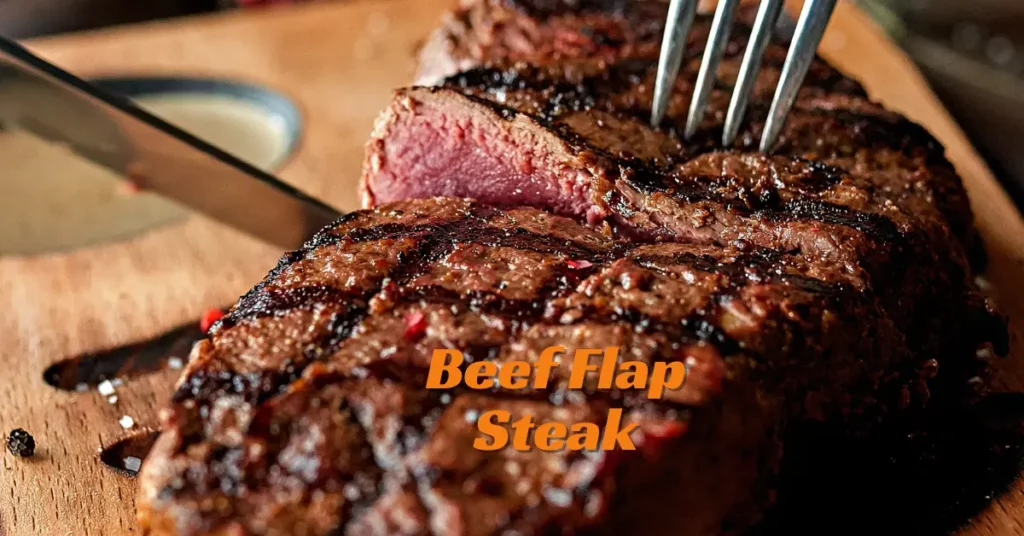This post may contain affiliate links. If you use these links to buy something we may earn a small commission. Thanks.
If you’ve never cooked beef flap steak before, you’re in for a flavorful surprise. This underrated cut of meat is packed with beefy richness, tender when handled right, and perfect for quick cooking. Whether you’re firing up the grill, searing on the stovetop, or experimenting with sous vide, beef flap steak also known as bavette offers a delicious dining experience without breaking the bank.
In this guide, we’ll walk you through everything you need to know about how to cook beef flap steak to perfection, from selecting the right cut to slicing and serving it like a pro.
What is Beef Flap Steak?
Beef flap steak comes from the bottom sirloin butt, near the flank and loin of the cow. It’s long, thin, and boasts a loose grain with visible marbling, which makes it extremely flavorful and quick to cook. Often mistaken for flank or skirt steak, flap steak has its own identity and culinary potential.
It’s known for its bold beefy flavor, and when cooked right, it delivers a juicy, tender bite. The coarse texture absorbs marinades beautifully, and its shape makes it perfect for slicing thinly ideal for fajitas, stir-fries, or simply plated as a main dish with a side of roasted vegetables.
Choosing the Best Flap Steak
Not all flap steaks are created equal. When shopping for this cut, look for:
- Deep red color: A sign of freshness and good oxygen exposure.
- Even marbling: Fat running through the muscle ensures juiciness.
- Uniform thickness: Helps cook the meat evenly across the surface.
Opt for grass-fed beef if you’re after a cleaner, slightly leaner taste, or go for grain-fed beef if you prefer richer marbling and a more buttery finish. Ask your butcher for a piece with the grain running lengthwise so you can slice it properly after cooking.

Prepping Flap Steak for Cooking
Before any heat touches the meat, a little prep work ensures maximum flavor.
1. Trim if Needed
Flap steak can come with some silverskin or excess fat. Use a sharp knife to carefully remove any tough or inedible pieces without taking off too much meat.
2. Season Generously
Simple salt and pepper go a long way, but this steak also welcomes bold spice rubs or seasoning blends. Try:
- Garlic powder
- Smoked paprika
- Crushed red pepper
- Cumin or coriander
Let it sit at room temperature for about 30 minutes after seasoning. This helps the meat cook evenly and absorb flavor.
3. Marinade (Optional, But Powerful)
If you have time, marinate your flap steak. The coarse grain soaks in flavors quickly. You can go light and zesty or rich and umami. Here are two go-to marinade ideas:
Citrus Garlic Marinade:
- Lime juice
- Olive oil
- Minced garlic
- Cilantro
- Chili flakes
Asian-Inspired Marinade:
- Soy sauce
- Rice vinegar
- Ginger
- Brown sugar
- Sesame oil
Let the steak marinate for at least 30 minutes, but no more than 24 hours, as over-marinating can break down the fibers too much.
Cooking Methods
Beef flap steak is versatile, but it shines brightest when cooked quickly over high heat and served medium-rare to medium. Here’s how to nail it with different methods.
A. Grilling Flap Steak
Grilling brings out the natural smokiness and charred exterior that flap steak loves.
Instructions:
- Preheat your grill to high heat (450°F to 500°F).
- Oil the grates to prevent sticking.
- Grill steak for 3–4 minutes per side for medium-rare (internal temp: 130°F).
- Let it rest for 5–10 minutes before slicing.
Pro Tip: Use tongs instead of a fork to flip the meat. Poking it lets juices escape.
B. Pan-Searing on Stovetop
No grill? No problem. A heavy skillet delivers beautiful browning and flavor.
Instructions:
- Heat a cast-iron skillet over medium-high heat until very hot.
- Add a high smoke-point oil like avocado or canola.
- Sear steak for 3–4 minutes per side, depending on thickness.
- In the last minute, add butter, garlic, and fresh herbs (like rosemary or thyme) and baste the steak.
- Rest before slicing.
This method creates a rich crust and works well year-round.
C. Broiling or Oven Roasting
The broiler mimics the high heat of grilling perfect for apartment dwellers.
Instructions:
- Place steak on a foil-lined baking sheet.
- Broil on high for 3–5 minutes per side, depending on thickness.
- Keep the oven door slightly ajar and watch closely to avoid overcooking.
Alternatively, you can reverse-sear the steak:
- Cook low and slow in the oven at 250°F until internal temp hits 115°F.
- Sear quickly in a hot pan or under a broiler to finish.
D. Sous Vide (Optional but Precise)
Sous vide gives you perfect doneness edge-to-edge.
Instructions:
- Set sous vide to 130°F for medium-rare.
- Seal steak in a vacuum or zipper bag with herbs and garlic.
- Cook for 1.5 to 2 hours.
- Remove, pat dry, and sear for 1 minute per side in a hot skillet.
You’ll get melt-in-your-mouth results every time.
Slicing and Serving Tips
This is where things can go wrong if you’re not careful. To get that perfect tenderness:
- Slice against the grain: Look at the muscle fibers and cut perpendicular to them.
- Use a sharp knife and make thin slices (about ¼ inch thick).
- Angle the knife for slightly diagonal cuts, enhancing surface area and tenderness.
Great toppings include:
- Chimichurri
- Garlic herb butter
- Balsamic glaze
- Roasted garlic aioli
What to Serve with Flap Steak
Flap steak pairs well with hearty and bright sides alike. Consider:
Starch Options:
- Roasted baby potatoes
- Garlic mashed potatoes
- Grilled corn on the cob
Veggie Companions:
- Charred asparagus
- Grilled bell peppers
- Roasted Brussels sprouts
Salads:
- Arugula with lemon vinaigrette
- Avocado and tomato salad
- Cucumber yogurt salad
Drinks:
- Red wine (Malbec, Zinfandel, Cabernet Sauvignon)
- Dark beer (Porter or Stout)
- Margarita or smoky mezcal cocktail
Storage and Leftovers
Cooked flap steak stores well and makes for great next-day meals.
- Refrigerator: Store in an airtight container for up to 4 days.
- Freezer: Wrap tightly in foil and freeze for up to 2 months.
- Reheating Tips: Warm gently in a pan with a splash of broth or water to keep it juicy.
Leftover Ideas:
- Beef tacos or burritos
- Steak fried rice
- Protein-packed salads
- Sandwiches or wraps with chimichurri mayo
Common Mistakes to Avoid
- Overcooking: Flap steak is best at medium-rare to medium. Anything beyond can make it chewy.
- Skipping the rest time: Letting it rest helps redistribute juices.
- Wrong slicing technique: Always cut against the grain for the best texture.
- Underseasoning: Don’t be shy this cut loves bold flavor.
- Crowding the pan: If pan-searing, don’t overcrowd or it’ll steam instead of sear.
Conclusion
Beef flap steak might just be your new favorite cut once you’ve cooked it right. It’s flavorful, versatile, and forgiving when treated with care. Whether you prefer it grilled, seared, or even cooked sous vide, the keys to success are proper seasoning, high heat, and slicing against the grain.
Give this underrated cut the attention it deserves and you’ll be rewarded with a juicy, satisfying meal every single time. Now that you know how to cook beef flap steak like a pro, it’s time to hit the kitchen (or grill) and let your taste buds thank you.
